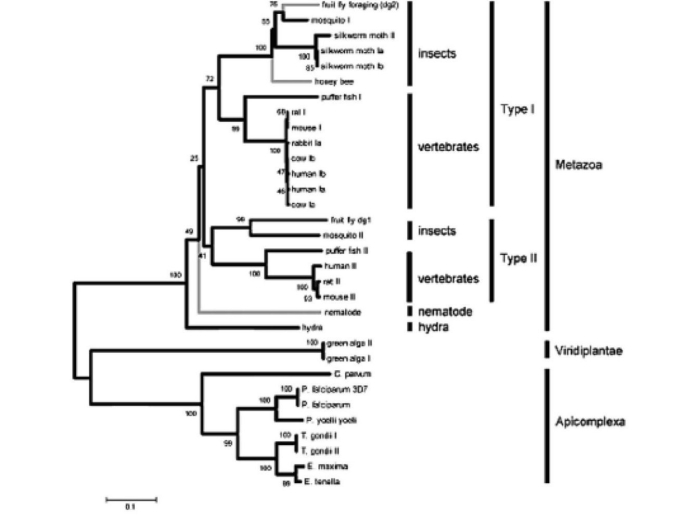Multiple Choice
Figure 51.6
Use the following information and Figure 51.6 when answering the corresponding question(s) .
The following are an abstract and figure from a paper that explores the evolutionary relationship between a protein kinase and behavior (M.Fitzpatrick and M.Sokolowski.2004.In search of food: Exploring the evolutionary link between cGMP-dependent protein kinase (PKG) and behavior.Integrative and Comparative Biology 44:28-36) .
Abstract:
Despite an immense amount of variation in organisms throughout the animal kingdom many of their genes show substantial conservation in DNA sequence and protein function.Here we explore the potential for a conserved evolutionary relationship between genes and their behavioral phenotypes.We investigate the evolutionary history of cGMP-dependent protein kinase (PKG) and its possible conserved function in food-related behaviors.First identified for its role in the foraging behavior of fruit flies,the PKG encoded by the foraging gene had since been associated with the maturation of behavior (from nurse to forager) in honey bees and the roaming and dwelling food-related locomotion in nematodes.These parallels encouraged us to construct protein phylogenies using 32 PKG sequences that include 19 species.Our analyses suggest five possible evolutionary histories that can explain the apparent conserved link between PKG and behavior in fruit flies,honey bees and nematodes.Three of these raise the hypothesis that PKG influences the food-related behaviors of a wide variety of animals including vertebrates.Moreover it appears that the PKG gene was duplicated some time between the evolution of nematodes and a common ancestor of vertebrates and insects whereby current evidence suggest only the for-like PKG might be associated with food-related behavior.

Neighbor joining trees depicting the evolutionary relationships of 32 PKG kinase domain and C-terminal amino acid sequences spanning 19 species of protozoans and metazoans.Values at the nodes represent the results of 5000 bootstrap replications.Lineages with known behavioral links with PKG are indicated by gray branches.
-Using Figure 51.6 and the accompanying paragraph,and knowing that the PKG encoded by the foraging gene has recently been associated with the maturation of out-of-nest behavior in honeybees,what would be a logical explanation for this relationship?
A) As animals mature,they require more food;therefore,PKG levels must increase.
B) As animals mature,they are more likely to forage;therefore,PKG levels must increase.
C) As animals mature,they respond to pheromones from the queen,which increases PKG levels.
D) As animals mature,they are able to fly,an activity that is connected to the increase in PKG levels.
Correct Answer:

Verified
Correct Answer:
Verified
Q6: The behavioral response associated with the escape
Q7: You have captured a number of rats
Q8: The principal prediction that can be made
Q9: A pied kingfisher in its first year
Q10: Based on your knowledge of cost-benefit analysis,why
Q12: A lizard's bobbing dewlap (a colorful flap
Q13: In the last phase of migration,birds seem
Q14: Figure 51.4 <img src="https://d2lvgg3v3hfg70.cloudfront.net/TB3734/.jpg" alt="Figure 51.4
Q16: Recent research has shown that von Frisch
Q49: Which of the following experiments best addresses